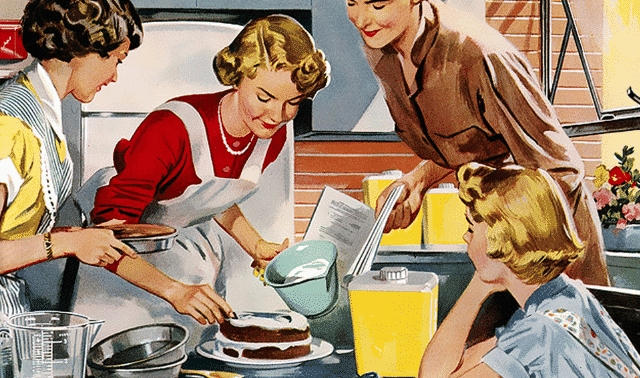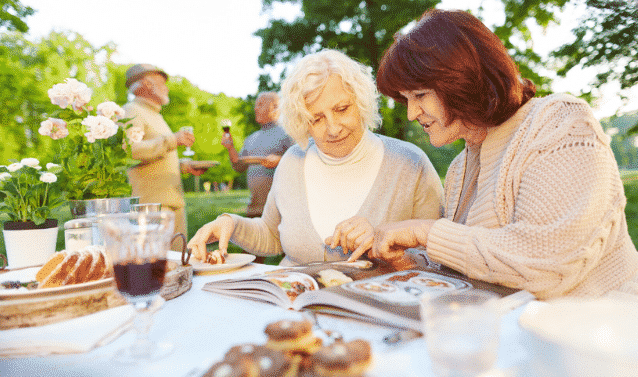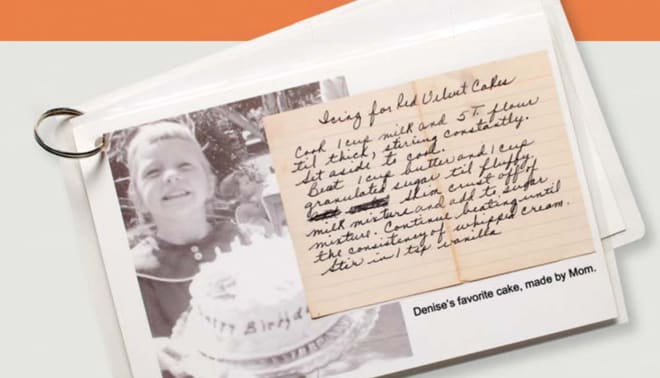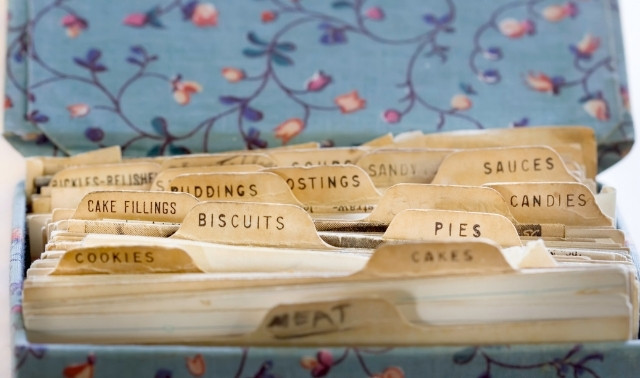A family recipe is like a time machine. One taste instantly transports you back to a time and place in your life when food brought family together. It could have been a picnic, a holiday celebration, a family dinner—or maybe the recipe brings you back to your mother’s or grandmother’s kitchen. These tiny time machines not only provide information on foods your family has enjoyed for generations, but they have the potential to create memories for generations to come.
That’s why it’s vital to collect these recipes before it’s too late, says Jillian Phillips, a family recipe collector. Phillips went in search of her mother’s Czechoslovakian cookie recipe. “I didn’t even like the cookies until I couldn’t have them anymore,” she says with a laugh.
But preserving memories isn’t the only reason to collect family recipes, says Pat Cornett, a food writer and former docent of the Longone Culinary Archives at the University of Michigan’s Clement Library in Ann Arbor, Mich. “Family recipes are important documents in the genealogical sense,” she says. “They preserve a personal part of our heritage and our pasts.”
You didn’t inherit a box full of food memories? Don’t worry—just use these strategies for collecting and sharing your family’s treasured family recipes.
Collecting Family Recipes
If your family recipe box is empty, there are several simple and fun ways you can fill it:
Use email and blogs
“It’s easy these days, with email, to contact relatives near and far and ask them to contribute their family recipes, or their favorite memories of foods they ate on special occasions,” says Cornett. If you write and email a family newsletter, that’s a perfect place to make a request, she adds.
Another option is to post a request for recipes on a blog or website. Cookbook author Michael Rosen, who collected family recipes from American chefs for his book Cooking from the Heart (Broadway), says a blog can be a convenient way to alert family members that you’d like a certain recipe, or to report on any recipes you’ve prepared. Suppose, for example, you tweaked an old family favorite and want to report your successful twist. And once family members start reading your blog, you can develop an ongoing discussion about all your family’s food treasures.
While technology has its advantages, remember that older relatives and those without access to a computer may miss out on recipe sharing. That’s why using more than one collecting strategy (even the old-fashioned telephone) is smart.
Host a potluck dinner or family reunion
Invite family members to bring their favorite dishes, along with the recipes, to a holiday dinner or reunion. That way, you can see, smell and taste the dish so you know how the recipe should turn out if you decide to make it in the future.
And why not take a picture of each relative along with his dish, as well as photos of other family members enjoying the food? That’s the kind of documentation families should keep along with their recipes, says Cornett. “Make a note as to when the recipe was served, who served it and who else was there to enjoy it,” she says.
Also, ask older relatives for their memories of the dish. Save your notes and photos along with the recipe. That way you’ll document not only the recipe, but also the family history surrounding the food.
Record the cook
Older, more experienced cooks often don’t cook from recipes, but from habit and memory. Ask for a recipe and you may hear “take a pinch of this” and “two yellow cupfuls of that.”
Rosen says that’s why he decided to start recording his relatives as they cooked. It not only clears up any mystery measurements (you can always stop the cook and measure what’s in the “yellow cup,” says Rosen) but the video also provides you with a cooking-lesson approach to more complicated recipes. “With those recipes, it’s usually better to watch the cook than to follow a list of complex steps,” Rosen explains.
Beyond that, videos also give you a priceless archive of a relative preparing a favorite family dish. You could create an entire video library of relatives cooking the dishes they’re best known for.
Strategies for Sharing Family Recipes
Once you’ve collected your recipes, the next step is to share them with other family members. Here are some ideas:
Create a family cookbook
Preserving recipes in a family cookbook is a popular way to share recipes with family members, and these books make especially nice gifts for both wedding and baby showers.
“I made my family cookbook to give to my son and his new wife at their wedding,” Cornett says. She had about 25 books printed up at a quick-print shop and gave them out at the rehearsal dinner.
Decide if the cookbook will be a family document, preserving every recipe in its original form, or a practical book. If you choose the latter, determine which recipes to use and how measurements will be written. Copy or type the recipes, adding memories and photos, then take the material to a graphic designer or design it yourself using desktop publishing software. Finally, take the finished layout to a copy shop to be printed. Cornett also suggests having the book spiral bound so it’s easy to use.
Start a recipe scrapbook
Archival scrapbooks can be good places to bring together recipes, memories, photos and art, but scrapbooks can be time-consuming to produce. And these one-of-a-kind works are difficult to share with others. If you love to scrapbook, however, and want to scrapbook family recipes, make copies of all original material and create your scrapbook from the copies. That way, you preserve the original material should you ever want to create additional scrapbooks for relatives.
Cook side by side
You also could try the approach family recipe collector Kathy Crocco uses. For years, she has collected food memories and recipes as oral histories, but she also invites younger family members to come to her place and cook alongside her. That’s how Crocco learned the recipes, and that’s how she likes to pass them along. “We talk and laugh and share stories and cook,” she says. “It’s a way to learn how to make the dish and to create memories at the same time. Cooking is a great way to bring family together.”
Share the food with family
Crocco says nothing creates demand for a recipe like actually consuming the food. When she brings her apple squares to a family gathering, for example, everyone wants the recipe, and she’s happy to share it. “I want family members to continue making this food,” she says. “It’s part of our family and part of our heritage.”
Although it can be difficult to motivate a younger generation to cook, Crocco makes a point to drop off a plate of Christmas cookies to family members each year—especially to those in the second generation. It’s a way to keep them in touch with their roots, she says, and they do ask for the recipes. They may not take the time to bake them now, she says, but they have the recipe for when they’re ready.
Bottle it
Tammy Cannavino and her sister Anita Senica have fond memories of their mother’s potica, an Eastern European pastry that was always served at Easter. The recipe came from the sisters’ Yugoslavian grandmother. “My sister and I wanted to keep the tradition going, so we decided to learn how to make it,” says Cannavino.
It took several efforts, but at last they perfected the recipe and served it to family. It was an instant hit. “You could sell this,” they were told.
So the sisters decided to give it a try. “We tweaked the recipe a bit so we could make smaller versions,” Cannavino says. A traditional potica is 18 inches long. The sisters trimmed it to 6- and 12-inch versions and set up a stand at a farmer’s market.
They sold out quickly. “We had customers who had their own memories of potica, but they told us they didn’t want to go to the trouble of making it,” says Cannavino. That’s all right with her. She and Senica are happy to share their family’s version of potica.
The original recipe, in their mother’s handwriting, is carefully preserved, says Cannavino. They work from a typed version, and no one but family can have a copy. Baking and selling potica have brought the two sisters closer together, and they’re pleased to keep the family tradition alive.
Recipe Trouble-Shooting Strategies
Recipe collecting can also have its glitches, so here are a few suggestions to help you through the rough spots.
Indecipherable handwriting and foreign languages
These are two of the most common problems in old family recipes. If the recipe is in another language, ask fluent family members to translate for you, or get help from a heritage club or a local university language department.
As for the handwriting, show the recipe to relatives to see if anyone is familiar with it and could give you an idea as to the cook’s intent. “Or search in cookbooks or online for similar recipes,” Rosen suggests.
Unfamiliar or archaic terminology
If the recipe hasn’t been updated since days gone by, you may find old-fashioned terms for ingredients, such as “loaf sugar” (granulated sugar) or “long sweetening” (molasses). If an ingredient is unfamiliar, look it up in the dictionary or an online food dictionary.
And what about archaic measurements, such as a saltspoon (1/4 teaspoon), a jigger (1 1/2 fluid ounces) or a peck (2 gallons dry)? Find a handy conversion chart for old measurements or consult old editions of classic cookbooks such as The Joy of Cooking, Better Homes and Gardens New Cookbook or Betty Crocker’s Picture Cookbook.
These cookbooks also will help you find suitable substitutions for kitchen equipment you may not have, such as pie weights (try dried beans) or a bacon press (use a foil-wrapped brick). They can give you a better understanding of cooking terms and techniques in general, too.
Hard-to-find or unhealthy ingredients
Almost any ingredient can be found online these days, says Rosen, who has located sources for sorghum molasses and heritage tomatoes. When it comes to dishes that pile mayonnaise on top of sour cream or require deep-frying in peanut oil, you can substitute healthier ingredients and cooking methods (get some ideas from the Mayo Clinic here), Rosen says, but be aware that you won’t end up with the same dish.
A better strategy is to do what chefs do when their food wouldn’t meet with a dieter’s approval: Cut recipes in half and serve smaller portions. “Small-plate food is very trendy right now,” Rosen says. You’ll get the taste your great-grandma intended, and she won’t roll over in her grave because you substituted PAM for lard.
A family without heritage recipes
If your family doesn’t have any traditional dishes, remember that the definition of “family” is flexible. “One woman I know who has no children created a beautiful family cookbook based on the recipes she and her husband served at dinners for friends,” Cornett says. Another woman put together a cookbook based on recipes her coworkers shared at company picnics and other functions.
Rosen thinks of family in a regional sense. If your family comes from the Appalachian area, for example, go back to that community and collect its recipes. Attend church dinners and potlucks and ask the cooks there for their recipes. “Local heritage societies and county fairs are great places to find the best cooks and the best recipes,” he says. You can also Google Appalachian recipes or traditional Peruvian dish.
If your family has a Polish background, for example, look through Polish cookbooks to see if you can recognize recipes as ones your family served. “Even if it’s not exactly the recipe as you remember it, you can always tweak it so it’s more like the dish you remember,” Rosen says.
Of course, the biggest problem is waiting too long to collect. “I’d advise anyone to get the recipes while they can,” Phillips says. Gathering your family food memories now will ensure they’re around for everyone to enjoy.
A version of this article appeared in the January 2011 issue of Family Tree Magazine.






